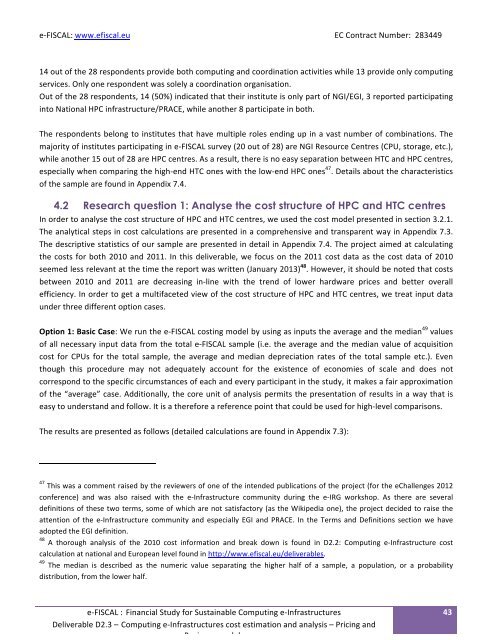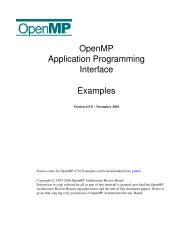D2 3 Computing e-Infrastructure cost calculations and business _models_vam1-final
D2 3 Computing e-Infrastructure cost calculations and business _models_vam1-final
D2 3 Computing e-Infrastructure cost calculations and business _models_vam1-final
You also want an ePaper? Increase the reach of your titles
YUMPU automatically turns print PDFs into web optimized ePapers that Google loves.
e-‐FISCAL: www.efiscal.eu <br />
EC Contract Number: 283449 <br />
14 out of the 28 respondents provide both computing <strong>and</strong> coordination activities while 13 provide only computing <br />
services. Only one respondent was solely a coordination organisation. <br />
Out of the 28 respondents, 14 (50%) indicated that their institute is only part of NGI/EGI, 3 reported participating <br />
into National HPC infrastructure/PRACE, while another 8 participate in both. <br />
The respondents belong to institutes that have multiple roles ending up in a vast number of combinations. The <br />
majority of institutes participating in e-‐FISCAL survey (20 out of 28) are NGI Resource Centres (CPU, storage, etc.), <br />
while another 15 out of 28 are HPC centres. As a result, there is no easy separation between HTC <strong>and</strong> HPC centres, <br />
especially when comparing the high-‐end HTC ones with the low-‐end HPC ones 47 . Details about the characteristics <br />
of the sample are found in Appendix 7.4. <br />
4.2 Research question 1: Analyse the <strong>cost</strong> structure of HPC <strong>and</strong> HTC centres<br />
In order to analyse the <strong>cost</strong> structure of HPC <strong>and</strong> HTC centres, we used the <strong>cost</strong> model presented in section 3.2.1. <br />
The analytical steps in <strong>cost</strong> <strong>calculations</strong> are presented in a comprehensive <strong>and</strong> transparent way in Appendix 7.3. <br />
The descriptive statistics of our sample are presented in detail in Appendix 7.4. The project aimed at calculating <br />
the <strong>cost</strong>s for both 2010 <strong>and</strong> 2011. In this deliverable, we focus on the 2011 <strong>cost</strong> data as the <strong>cost</strong> data of 2010 <br />
seemed less relevant at the time the report was written (January 2013) 48 . However, it should be noted that <strong>cost</strong>s <br />
between 2010 <strong>and</strong> 2011 are decreasing in-‐line with the trend of lower hardware prices <strong>and</strong> better overall <br />
efficiency. In order to get a multifaceted view of the <strong>cost</strong> structure of HPC <strong>and</strong> HTC centres, we treat input data <br />
under three different option cases. <br />
Option 1: Basic Case: We run the e-‐FISCAL <strong>cost</strong>ing model by using as inputs the average <strong>and</strong> the median 49 values <br />
of all necessary input data from the total e-‐FISCAL sample (i.e. the average <strong>and</strong> the median value of acquisition <br />
<strong>cost</strong> for CPUs for the total sample, the average <strong>and</strong> median depreciation rates of the total sample etc.). Even <br />
though this procedure may not adequately account for the existence of economies of scale <strong>and</strong> does not <br />
correspond to the specific circumstances of each <strong>and</strong> every participant in the study, it makes a fair approximation <br />
of the “average” case. Additionally, the core unit of analysis permits the presentation of results in a way that is <br />
easy to underst<strong>and</strong> <strong>and</strong> follow. It is a therefore a reference point that could be used for high-‐level comparisons. <br />
The results are presented as follows (detailed <strong>calculations</strong> are found in Appendix 7.3): <br />
47 This was a comment raised by the reviewers of one of the intended publications of the project (for the eChallenges 2012 <br />
conference) <strong>and</strong> was also raised with the e-‐<strong>Infrastructure</strong> community during the e-‐IRG workshop. As there are several <br />
definitions of these two terms, some of which are not satisfactory (as the Wikipedia one), the project decided to raise the <br />
attention of the e-‐<strong>Infrastructure</strong> community <strong>and</strong> especially EGI <strong>and</strong> PRACE. In the Terms <strong>and</strong> Definitions section we have <br />
adopted the EGI definition. <br />
48 A thorough analysis of the 2010 <strong>cost</strong> information <strong>and</strong> break down is found in <strong>D2</strong>.2: <strong>Computing</strong> e-‐<strong>Infrastructure</strong> <strong>cost</strong> <br />
calculation at national <strong>and</strong> European level found in http://www.efiscal.eu/deliverables. <br />
49 The median is described as the numeric value separating the higher half of a sample, a population, or a probability <br />
distribution, from the lower half. <br />
e-‐FISCAL : Financial Study for Sustainable <strong>Computing</strong> e-‐<strong>Infrastructure</strong>s <br />
Deliverable <strong>D2</strong>.3 – <strong>Computing</strong> e-‐<strong>Infrastructure</strong>s <strong>cost</strong> estimation <strong>and</strong> analysis – Pricing <strong>and</strong> <br />
Business <strong>models</strong> <br />
43




